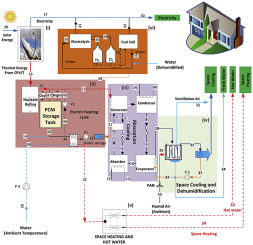International Journal of Hydrogen Energy ( IF 7.2 ) Pub Date : 2018-12-29 , DOI: 10.1016/j.ijhydene.2018.12.047 Shoukat Alim Khan , Yusuf Bicer , Muammer Koç

|
Concentrated photovoltaics (CPV) is an auspicious technology to overcome the high cost problem of highly efficient multi-junction solar cells. However, due to huge concentration of light energy, high heat flux dissipation from a confined space is a challenge. The proposed system here is first of its type to apply and thermodynamically analyze the Nucleate Pool Boiling Heat Transfer (NBHT) for thermal management of CPV. In order to increase overall efficiency of CPV system, a multigeneration system using concentrated photovoltaic thermal (CPV/T) and hydrogen storage is designed and thermodynamically analyzed to fulfill electricity, hot and cold water, heating ventilation and cooling (HVAC) requirement of a residential community with continuous operation. A part of the generated electricity from CPV is used to power the electrolyzer to produce hydrogen and oxygen. The produced gases are stored, and reused by proton exchange membrane fuel cell (PEMFC) to fulfill the system's electrical energy requirement during night time and unfavourable energy conditions in day time. The resultant thermal energy from CPV/T is used for the heating, hot water and cooling requirement of the buildings by employing lithium bromide absorption chiller (AbC). A humidity harvesting system is connected, at the outlet of the absorption chiller, to convert humid air into water and ventilation air requirement of the building. The designed system performs at 67.52% overall energy efficiency, 34.89% of overall exergy efficiency and up to 1862 times concentration ratio at designed steady-state conditions. The results show that with an increase in boiling temperature of NBHT from 353 K to 373 K, the maximum concentration ratio ability increases significantly from 1392 to 2400 times due to increase in critical heat flux, while the electrical efficiency of the CPV system decreases from 28.65% to 27.09% because of increase in cell temperature. To verify the performance of the designed system for different locations, operating conditions and capacities, the effects of Direct Normal Irradiance , ambient temperature, relative humidity ratio and the installed capacity are also analyzed by the parametric studies.
中文翻译:

聚光光伏热(CPV / T)和储氢的多代系统的设计和分析
聚光光伏(CPV)是一种吉祥技术,可以克服高效多结太阳能电池的高成本问题。然而,由于光能的高度集中,来自密闭空间的高热通量消散是一个挑战。此处提出的系统是此类系统中的第一个,可用于对CPV进行热管理的核池沸腾传热(NBHT)并对其进行热力学分析。为了提高CPV系统的整体效率,设计并使用了集中光伏热(CPV / T)和储氢的多代系统,并对其进行了热力学分析,以满足住宅的用电,冷热水,供暖通风和制冷(HVAC)的要求社区不断运作。CPV产生的一部分电能用于为电解槽供能,以产生氢气和氧气。储存产生的气体,然后由质子交换膜燃料电池(PEMFC)再利用,以在夜间满足白天系统的电能需求,并在白天不利的能源条件下满足需求。CPV / T产生的热能通过使用溴化锂吸收式制冷机(AbC)用于建筑物的供暖,热水和制冷需求。在吸收式制冷机的出口处连接了一个湿度收集系统,以将湿空气转化为建筑物的水和通风空气。在设计的稳态条件下,设计的系统可实现67.52%的总能效,34.89%的总火用能效,并且达到1862倍的浓缩比。结果表明,随着NBHT沸腾温度从353 K增加到373 K,由于临界热通量的增加,最大浓缩比能力从1392倍增加到2400倍,而CPV系统的电效率从28.65降低由于电池温度的升高,%到27.09%。验证所设计系统在不同位置,运行条件和容量下的性能,以及直接正向辐照度的影响,环境温度,相对湿度比和装机容量也通过参数研究进行了分析。


























 京公网安备 11010802027423号
京公网安备 11010802027423号